Hirschsprung’s disease - Study guides, Class notes & Summaries
Looking for the best study guides, study notes and summaries about Hirschsprung’s disease? On this page you'll find 337 study documents about Hirschsprung’s disease.
Page 2 out of 337 results
Sort by
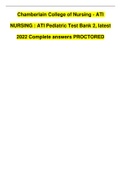
-
Chamberlain College of Nursing - ATI NURSING : ATI Pediatric Test Bank 2, latest 2022 Complete answers PROCTORED
- Exam (elaborations) • 39 pages • 2022
-
- $12.49
- 1x sold
- + learn more
Chamberlain College of Nursing - ATI NURSING : ATI Pediatric Test Bank 2, latest 2022 Complete answers PROCTORED A nurse is planning to care for a child who has severe diarrhea. Which of the following actions is the nurse's priority? A. Introduce a regular diet B. Rehydrate C. Maintain fluid therapy D. Assess fluid balance (Assess first the other three are interventions, before you intervene you have to assess how much fluid imbalance. Check for lab results because it will tell you what ...
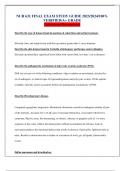
-
NUR 631 FINAL EXAM STUDY GUIDE 2023/2024/100% VERIFIED/A+ GRADE
- Exam (elaborations) • 26 pages • 2023
-
- $12.49
- + learn more
NUR 631 FINAL EXAM STUDY GUIDE 2023/2024/100% VERIFIED/A+ GRADE Definitions/Descriptions Describe the type of lesions found in psoriasis & seborrheic and actinic keratosis. Elevated, firm, and rough lesion with flat top surface greater than 1 cm in diameter Describe the skin lesions found in Varicella (chickenpox) and herpes zoster (shingles). Elevated circumscribed, superficial lesion filled with serous fluid, less than 1 cm in diameter Describe the pathogenetic mechanism of polycyst...
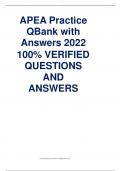
-
TESTBANK APEA Practice Questions with Answers 100% VERIFIED QUESTIONS AND ANSWERS
- Exam (elaborations) • 12 pages • 2024
-
- $17.89
- + learn more
TESTBANK APEA Practice Questions with Answers 100% VERIFIED QUESTIONS AND ANSWERS . Located on the anterior aspect of the distal femur, the patella slides on this groove during flexion and extension of the knee. The name of this groove is the: a. Trochlear groove 49. A 86-year-old man with uncontrolled hypertension presents with sudden, intense left lower abdominal pain that radiates to the back. The pain is associated with a tearing sensation. These findings are MOST likely associated w...
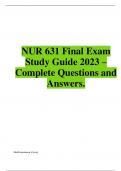
-
NUR 631 Final Exam Study Guide 2023 – Complete Questions and Answers | Latest Guide 2023
- Exam (elaborations) • 40 pages • 2023
-
- $15.99
- + learn more
NUR 631 Final Exam Study Guide 2023 – Complete Questions and Answers. Describe the type of lesions found in psoriasis & seborrheic and actinic keratosis. Elevated, firm, and rough lesion with flat top surface greater than 1 cm in diameter Describe the skin lesions found in Varicella (chickenpox) and herpes zoster (shingles). Elevated circumscribed, superficial lesion filled with serous fluid, less than 1 cm in diameter Describe the pathogenetic mechanism of polycystic ovarian syndrome (POS). P...
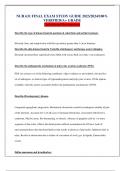
-
NUR 631 FINAL EXAM STUDY GUIDE 2023/2024/100% VERIFIED/A+ GRADE Definitions/Descriptions
- Exam (elaborations) • 26 pages • 2023
-
Available in package deal
-
- $11.99
- + learn more
Describe the type of lesions found in psoriasis & seborrheic and actinic keratosis. Elevated, firm, and rough lesion with flat top surface greater than 1 cm in diameter Describe the skin lesions found in Varicella (chickenpox) and herpes zoster (shingles). Elevated circumscribed, superficial lesion filled with serous fluid, less than 1 cm in diameter Describe the pathogenetic mechanism of polycystic ovarian syndrome (POS). POS has at least two of the following conditions: oligo-ovulation...
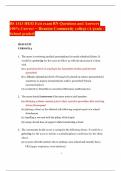
-
BS 1343 HESI Exit exam RN Questions and Answers 100% Correct – Houston Community college (A grade / School graded)
- Exam (elaborations) • 80 pages • 2024
-
- $25.49
- + learn more
BS 1343 HESI Exit exam RN Questions and Answers 100% Correct – Houston Community college (A grade / School graded) HESI EXIT VERSION 3 1. The nurse is reviewing medical prescriptions for newly admitted clients. It would be a priority for the nurse to follow up with the physician if a client with (a) a potassium level of 4.5mEq/L has Kayexalate (sodium polystyrene) prescribed (b) a Dilantin (phenytoin) level of 8 mcg/ml is placed on seizure precautions(c) sensitivity to Aspirin (acetyls...
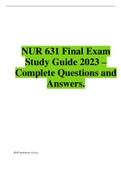
-
NUR 631 Final Exam Study Guide 2023 – Complete Questions and Answers | Latest Guide 2023
- Exam (elaborations) • 40 pages • 2023
-
- $15.99
- + learn more
NUR 631 Final Exam Study Guide 2023 – Complete Questions and Answers. Describe the type of lesions found in psoriasis & seborrheic and actinic keratosis. Elevated, firm, and rough lesion with flat top surface greater than 1 cm in diameter Describe the skin lesions found in Varicella (chickenpox) and herpes zoster (shingles). Elevated circumscribed, superficial lesion filled with serous fluid, less than 1 cm in diameter Describe the pathogenetic mechanism of polycystic ovarian syndrome (POS). P...
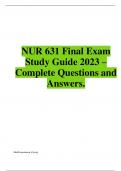
-
NUR 631 Final Exam Study Guide 2023 – Complete Questions and Answers | Latest Guide 2023
- Exam (elaborations) • 40 pages • 2023
-
- $17.99
- + learn more
NUR 631 Final Exam Study Guide 2023 – Complete Questions and Answers. Describe the type of lesions found in psoriasis & seborrheic and actinic keratosis. Elevated, firm, and rough lesion with flat top surface greater than 1 cm in diameter Describe the skin lesions found in Varicella (chickenpox) and herpes zoster (shingles). Elevated circumscribed, superficial lesion filled with serous fluid, less than 1 cm in diameter Describe the pathogenetic mechanism of polycystic ovarian syndrome (POS). P...
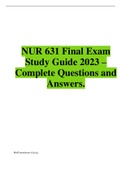
-
NUR 631 Final Exam Study Guide 2023 – Complete Questions and Answers | Latest Guide 2023
- Exam (elaborations) • 40 pages • 2023
-
- $13.99
- + learn more
NUR 631 Final Exam Study Guide 2023 – Complete Questions and Answers. Describe the type of lesions found in psoriasis & seborrheic and actinic keratosis. Elevated, firm, and rough lesion with flat top surface greater than 1 cm in diameter Describe the skin lesions found in Varicella (chickenpox) and herpes zoster (shingles). Elevated circumscribed, superficial lesion filled with serous fluid, less than 1 cm in diameter Describe the pathogenetic mechanism of polycystic ovarian syndrome (POS). P...
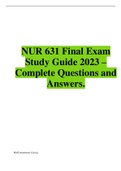
-
NUR 631 Final Exam Study Guide 2023 – Complete Questions and Answers | Latest Guide 2023
- Exam (elaborations) • 40 pages • 2023
-
- $14.99
- + learn more
NUR 631 Final Exam Study Guide 2023 – Complete Questions and Answers. Describe the type of lesions found in psoriasis & seborrheic and actinic keratosis. Elevated, firm, and rough lesion with flat top surface greater than 1 cm in diameter Describe the skin lesions found in Varicella (chickenpox) and herpes zoster (shingles). Elevated circumscribed, superficial lesion filled with serous fluid, less than 1 cm in diameter Describe the pathogenetic mechanism of polycystic ovarian syndrome (POS). P...

Study stress? For sellers on Stuvia, these are actually golden times. KA-CHING! Earn from your study resources too and start uploading now. Discover all about earning on Stuvia


